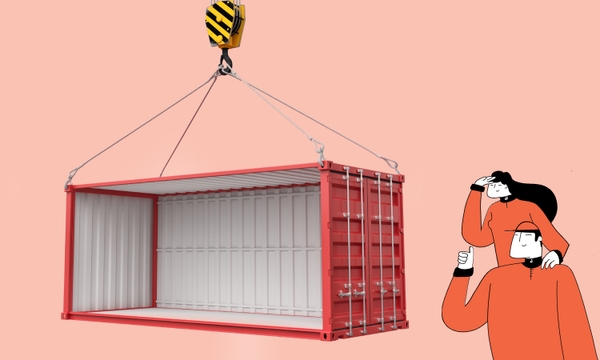Tare Weight

An essential part of shipping is weight measurements. This is because the cost of shipping is often determined by the weight of the shipment. Inaccurate weight measurements can result in either overpaying or underpaying for shipping, which can be a significant problem for businesses.
One of the important measurements in international shipping is tare weight. We discuss everything about it in this article.

What is Tare Weight?
Tare weight, also known as tare mass or simply tare, is the weight of an empty container. The term is commonly used in reference to shipping containers, including but not limited to maritime cargo containers, motor vehicle trailers, and railway cars.
Tare weight allows for the determination of net weight, which is the weight of the product alone. It is important to have an accurate tare weight as it allows for proper billing and shipping of products.
Tare weight can be determined in a number of ways, including through the use of scales or other measuring devices. It is often expressed as a percentage of the total weight of the container and its contents. For example, if a container has a tare weight of 10%, the net weight of the product would be 90%.
It is important to note that tare weight is different from deadweight, which is the total weight of the container and its contents, including the tare weight.
What is the Tare Weight Limit?
The tare weight limit is the maximum weight a shipping container can carry without any cargo inside. This limit is important to know because it can affect the amount of freight that can be shipped in a container.
For example, if a shipper has a 20-foot container with a tare weight limit of 24,000 pounds, they can only ship 4,000 pounds of cargo in that container. If they exceed the tare weight limit, they may be subject to overage charges from their shipping company.
The tare weight limit is typically set by the shipping company and varies depending on the type of container. For example, a 20-foot standard container has a tare weight limit of 24,000 pounds, while a 40-foot standard container has a tare weight limit of 39,600 pounds.
It’s important to note that the tare weight limit does not include the weight of the cargo. So, if you’re shipping 4,000 pounds of cargo in a 20-foot container, the total weight of the shipment will be 28,000 pounds (24,000 pounds + 4,000 pounds).
How Do You Calculate the Tare Weight?
The tare weight is the weight of a container and its contents. The net weight is the weight of the product itself. To calculate the tare weight, you will need to:
- Know the gross weight of the container and its contents.
- Subtract the net weight of the product from the gross weight.
- The difference is the tare weight.
For example, if the gross weight of a container and its contents is 1,000 kg and the net weight of the product is 950 kg, the tare weight would be 50 kg.
What is Gross Weight?
Gross weight is the total weight of a shipment, including the product, packaging, and other materials used to prepare the shipment for transport. In international shipping, gross weight is often used to determine shipping charges and customs duties.
When calculating the gross weight of a shipment, it is important to use an accurate and consistent method. The most common method is to weigh the shipment on a scale. However, you can also estimate the gross weight by using the dimensions of the shipment and a standard weight per unit of measure (such as pounds per square foot).
It is important to note that the term "gross weight" can have different meanings in different countries. In some countries, gross weight includes the weight of the product and packaging, while in others it does not. Be sure to check with your local shipping regulations to determine the definition of gross weight in your country.
What is the Difference Between Tare and Gross Weight?
The difference between tare and gross weight is that tare weight is the weight of an empty container and its packaging, while gross weight includes the weight of the container, its packaging, and its contents.
Tare weight is important in shipping because it allows for the accurate calculation of a shipment's total weight. This total weight is then used to determine the shipping costs.
Gross weight, on the other hand, is the total weight of a shipment, including the weight of the container, packaging, and contents. This weight is important for determining how much a shipment will cost to ship.
Tare weight is usually expressed in kilograms or pounds, while gross weight is typically expressed in tons.
It is important to note that a shipment's tare weight and gross weight of a shipment can vary depending on the type and size of the container used. For example, a larger container will generally have a higher tare weight than a smaller container.
How are Containers and Cargo Weighed?
There are two main ways that containers and cargo are weighed — by using a weighbridge or by using container weight sensors.
Weighbridges are large, heavy-duty scales that can weigh entire trucks, trailers, and even trains. They're typically found at ports, terminals, and other places where large vehicles need to be weighed.
Container weight sensors, on the other hand, are smaller devices that can be attached to individual containers. These sensors can weigh the contents of a container without needing to weigh the entire vehicle.
Several factors can affect the accuracy of a weighbridge or sensor, including the type of scale being used, the weight of the vehicle or container, the amount of cargo being weighed, and the environment where the weighbridge or sensor is located. For example, windy conditions can cause a weighbridge to give an inaccurate reading.
It's important to calibrate weighbridges and sensors regularly to ensure that they're providing accurate readings. This can be done using certified weights or comparing the readings from multiple scales.
Why is it Important to Weigh Cargo?
There are several reasons why it's important to accurately weigh containers and cargo. First, it helps ensure that vehicles are not overloaded, which can cause accidents. Second, it helps ensure that the correct amount of taxes and fees are paid on the goods being shipped. And third, it helps businesses keep track of their inventory and ensure they're not losing money due to incorrect weight estimates.


